Why Product Management Is Important: Complete Guide (2025)
Discover why product management is crucial for business success, bridging customer needs, design, engineering, and strategy.

In a workshop with an early‑stage machine‑learning startup we watched a team build a beta product in three months without a clear vision. They released features based on gut feel and anecdotal feedback. Budgets were stretched, morale dipped and users churned because the product failed to address real problems.
This isn’t an isolated story. Many young companies launch with enthusiasm but stumble because there’s no systematic way to translate market needs into a coherent product. The discipline of product management exists to prevent those missteps. It isn’t just about shipping features; it’s about ensuring a product serves the business, satisfies customers, encourages innovation and stands out in a crowded market.
Throughout this guide we’ll explore what product management is, why it matters and how founders, product leaders and designers can harness it to build focused, user‑centred products. By the end you’ll understand why product management is important and how to embed it into your startup from day one.
What product management really is?
Product management guides a product from conception to market success. The CPO Club describes it as “the reason an organisation exists … to deliver great products to customers and hopefully make tons of cash”. It spans market research, vision setting, planning, development, launch and continuous improvement. SafetyCulture defines it as overseeing the product lifecycle from concept to release and later stages while ensuring the product remains high‑quality and profitable. A product manager synthesises insights from customers, business goals and technology to make decisions and drive the roadmap.
While product management and project management are often conflated, they’re distinct. Product managers focus on what should be built and why, whereas project managers focus on how and when. The CPO Club emphasises that product managers bridge user experience, engineering and business goals and prioritise customer value over task completion. Another misconception is that a product manager is just a proxy for the product owner in agile frameworks. In practice the roles overlap, but the product owner’s remit is often tactical (backlog grooming, sprint planning), while product managers keep the strategic vision and market fit in view.
The product lifecycle
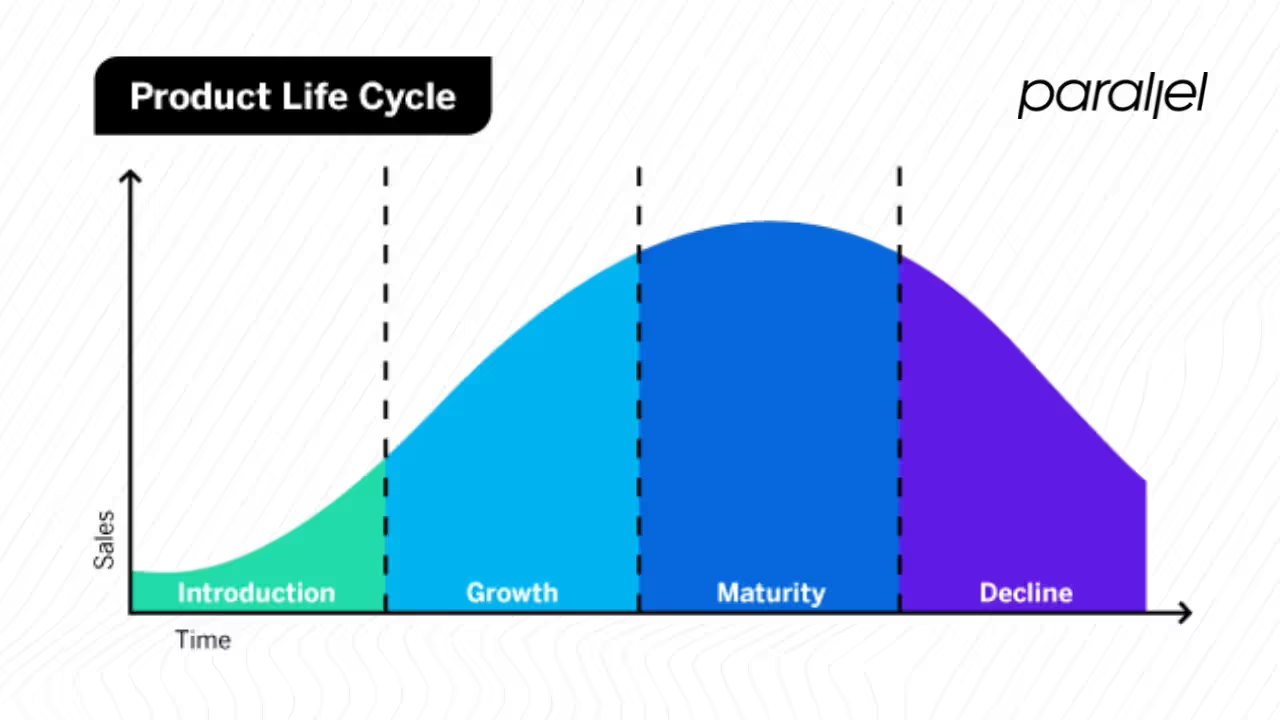
Understanding the product lifecycle helps explain why product management is important. A product passes through ideation, development, launch, growth, maturity and eventually retirement. Each stage demands different strategies. For example, in early stages product managers focus on identifying unmet needs and testing value propositions. During growth they prioritise scalability and feature differentiation. Near maturity they look for adjacent markets or plan end‑of‑life decisions. Without continuous attention the product can stagnate or miss the window of opportunity. The SafetyCulture article details these phases: discovery (identifying customer needs), planning (defining the product and roadmap), development (building and testing), launch and maintenance. Product management ensures every transition is intentional and connected to business goals.
Core functions
A full view of the product manager’s role reveals why product management is important for early‑stage startups. The main functions include:
- Market analysis: researching customer segments, competitive landscapes and trends to inform positioning and differentiation.
- Vision and strategy: defining a compelling product vision connected to business objectives and setting clear success metrics.
- Roadmap prioritisation: deciding which features and improvements deliver the most value given limited resources.
- User experience: ensuring the product solves real user problems and is intuitive to use. As SafetyCulture explains, product managers must figure out what users need and ensure those needs are met.
- Stakeholder communication: bringing executives, engineering, design, marketing and sales together around the product strategy.
- Cross‑functional collaboration: serving as a conduit among teams, bridging user empathy and technical feasibility.
- Measurement: tracking metrics like adoption, revenue, retention, customer satisfaction and profitability to guide decisions.
Early startups operate under constraints. There’s little margin for building the wrong thing. These functions help founders navigate uncertainty, allocate resources and avoid the high failure rates of new products—nearly 95% of physical consumer products and 85% of big data projects fail. This high failure rate underscores why product management is important: it increases the odds that you’ll launch a viable product rather than becoming a cautionary tale.
Business strategy and market competitiveness
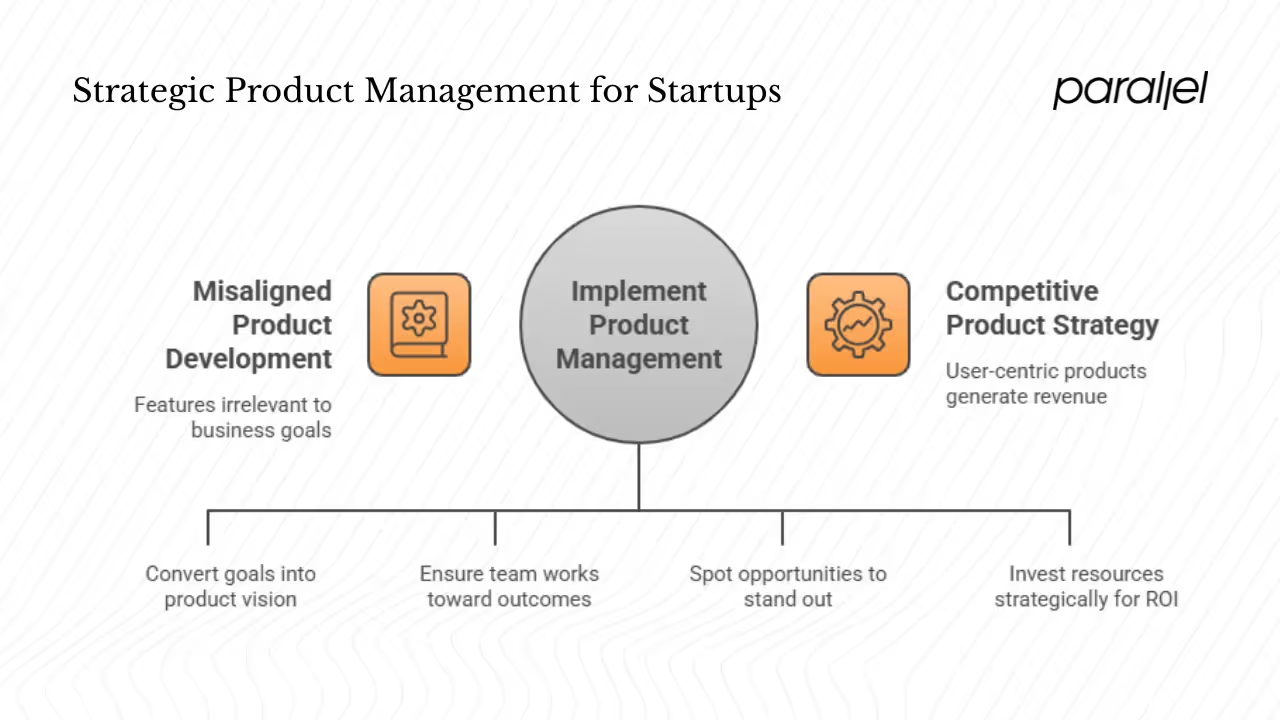
Connecting product to strategy
Product management sits at the centre of strategic execution. The CPO Club’s article points out that product management is the reason an organisation exists because it turns strategy into user‑centric products that generate revenue. A product manager’s first job is to translate company objectives—such as entering a new market or increasing revenue—into a product vision. They then connect the roadmap to the organisation’s goals and ensure the team is working toward measurable outcomes. Without this connection you may produce features that are well designed but irrelevant to the business.
According to the Martyn Bassett Associates report, chief product officers sit at the strategic core of a company’s growth and innovation efforts. They manage the product portfolio, develop the vision, lead cross‑functional teams and conduct market research. In early‑stage startups, even if you don’t have a CPO, the founder or a senior product leader should embody this role: connecting company ambitions with a clear product strategy.
Driving competitiveness
Great product management isn’t just about internal connection; it also ensures the product stays competitive. The SEI blog explains that product management can be a distinctive factor in competitive markets. By continuously analysing competitors, market trends and customer feedback, product managers spot opportunities to stand out—through superior features, better pricing models or unique value propositions. They help answer questions like: Should we build this feature or partner? Should we pivot the product to serve a new segment? Which emerging technologies could unlock an advantage?
Product managers also decide where to invest limited resources. They evaluate which features will deliver the biggest impact on revenue or market share. This strategic allocation is part of why product management is important for startups. Without someone thinking about ROI, teams may chase nice‑to‑have features that don’t move the needle. According to ProductPlan’s 2024 report, 46% of product strategy decisions are influenced by senior leadership or sales feedback, while only 27% come from customer feedback and 21% from competition. Startups that emphasise market and customer insights often achieve closer ties to company goals and higher strategy effectiveness, proving the value of a disciplined product function.
Customer satisfaction and user experience
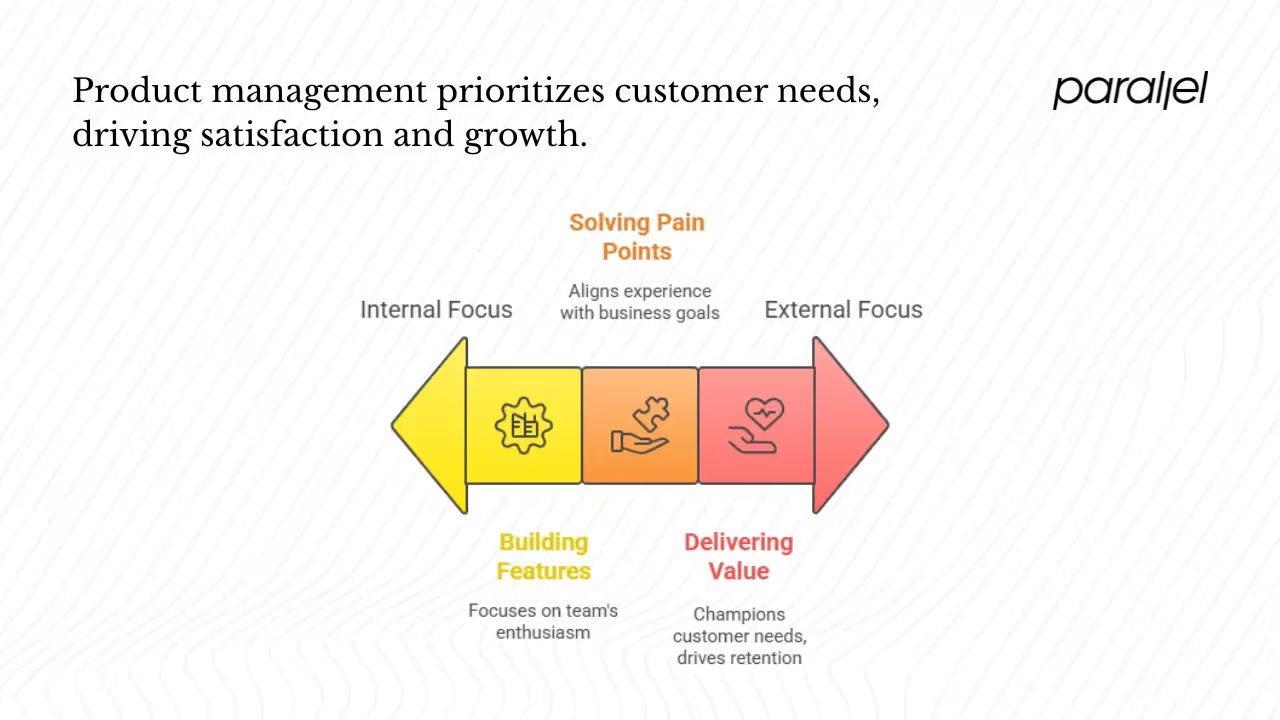
Delivering customer value
At its core product management is about delivering value. SafetyCulture explains that product managers oversee the development and launch of new products, relying on deep research and prioritisation to ensure the product meets users’ needs. This user‑centric mindset helps avoid building features that excite the team but fail to resonate with customers. In practice this means conducting user interviews, analysing feedback, observing behaviour and validating assumptions before and after launch. When product managers champion customer needs, they drive retention and advocacy, which are critical for early‑stage growth.
User experience as a differentiator
User experience isn’t just the domain of designers; it’s a strategic lever for product managers. A product manager ensures the experience solves pain points, fits the business model and supports long‑term goals. Good usability reduces support costs, accelerates onboarding and increases satisfaction. The CPO Club emphasises that product managers bridge user experience and engineering, ensuring customer value isn’t sacrificed for feasibility. Startups that ignore this risk high churn and negative word of mouth.
Measuring customer satisfaction helps teams stay accountable. Important metrics include customer satisfaction (CSAT), net promoter score (NPS), retention rates and time to value. These metrics should inform product decisions. A drop in NPS might signal a confusing onboarding flow or missing feature. Retention analysis can reveal whether customers find sustained value. By making data part of the conversation, product managers avoid subjective debates and anchor decisions in evidence, which underscores the value of having a dedicated product function.
Product development and time‑to‑market
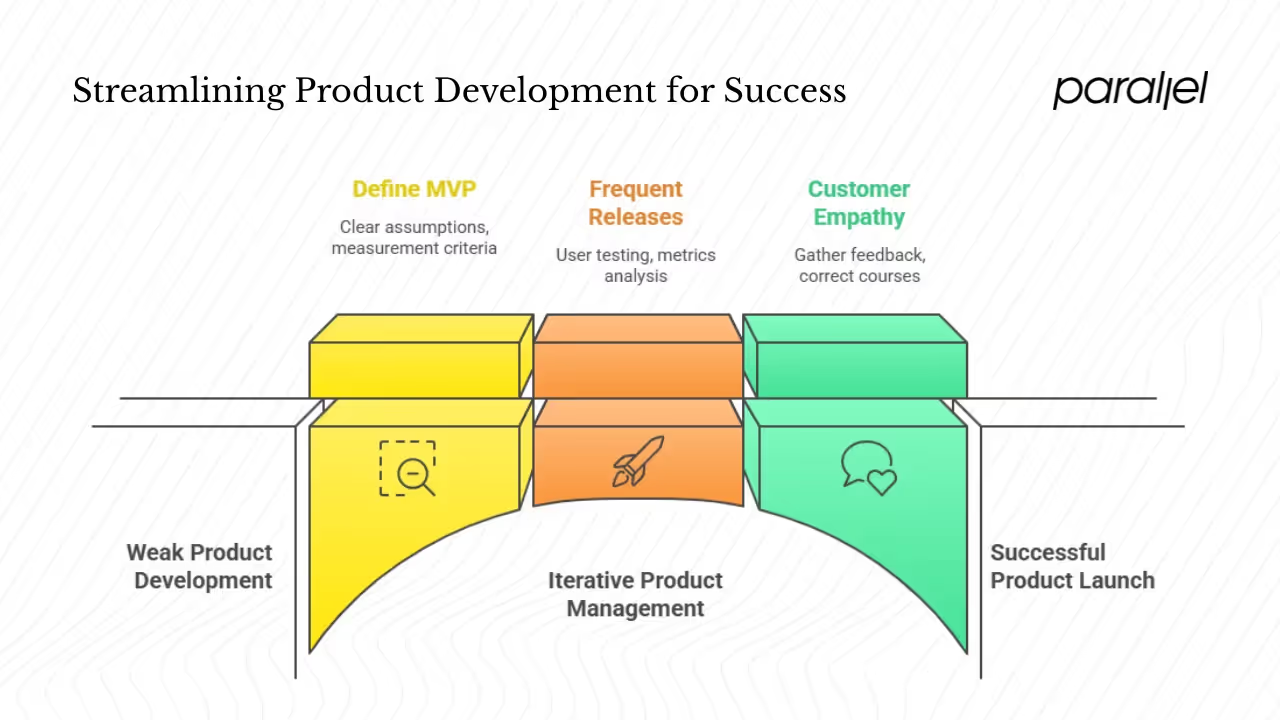
Managing development with intention
Product management isn’t limited to idea generation; it orchestrates how ideas become reality. The SEI blog compares product management, technology and process to three legs of a stool: if any leg is weak the product suffers. A product manager works closely with engineering and design to shape the roadmap, prioritise features and sequence work. They balance technical constraints, business objectives and user needs.
The urgency of timing
Time‑to‑market can make or break a startup. Release too early and you may deliver a half‑baked product that damages your reputation. Release too late and competitors may capture your audience. Product managers help set realistic timelines and manage trade‑offs. They decide when to release a minimum viable product (MVP) to gather feedback and when to invest in robust features. They also recognise when to cut scope to avoid missed windows. In our experience working with machine‑learning‑focused SaaS teams, those who define an MVP with clear assumptions and measurement criteria learn faster and waste fewer resources.
Minimising risk through iteration
High failure rates of new products show why iterative development is crucial. SEI emphasises that without customer empathy and feedback it’s often too late when teams realise there’s no market for their solution. A disciplined product function implements iterative cycles: build, measure, learn. Frequent releases, user testing and metrics analysis reduce risk by allowing teams to correct courses early. MVPs and prototypes provide data points rather than theoretical debates. This disciplined approach encourages learning and mitigates waste.
Cross‑functional collaboration and stakeholder communication
Product as a hub
A product manager is often compared to a hub connecting spokes: engineering, design, marketing, sales, support and executives. The CPO Club describes product managers as conductors of cross‑functional teams, bringing stakeholders together around a unified product strategy. They must communicate effectively, listen to concerns and persuade others without direct authority. This is challenging but essential. Harvard Business Review research cited by ProductSchool found that 75% of cross‑functional teams are dysfunctional. Dysfunction arises when teams work in silos or lack a shared vision. Product managers bring everyone together by clarifying goals, explaining trade‑offs and maintaining transparency.
Practical communication techniques
For early‑stage startups cross‑functional collaboration can be fluid because teams are small, but it still requires intentional communication. Effective product managers:
- Host regular roadmap reviews to bring leadership and delivery teams together.
- Maintain a single source of truth for product decisions and rationale.
- Involve engineers and designers early in problem discovery so solutions are technically feasible and creative.
- Encourage cross‑team demos, as ProductSchool suggests, to break silos and inspire shared ownership.
- Communicate customer insights to the organisation so everyone understands the problem space.
Good communication not only keeps everyone in sync and builds trust. When stakeholders see how decisions tie back to data and strategy, they’re more likely to support trade‑offs. Clear communication prevents rework, reduces confusion and accelerates decision‑making.
Innovation and market analysis
Staying ahead of the curve
Innovation isn’t just about big bets; it often comes from continuous, incremental improvements. The Kaizen philosophy emphasises small, continuous changes that yield significant improvements over timebeyondthebacklog.com. In the context of product management this means iterating on features, learning from feedback and building a mindset of experimentation. Kaizen fits with product management by promoting agility, customer‑centric focus and cross‑functional collaboration. These principles encourage teams to respond quickly to market shifts and build products that evolve with customer needs.
The role of market analysis
Product managers must constantly scan the horizon. This includes analysing competitors, understanding customer segments and tracking emerging technologies. Market analysis answers critical questions: Which segments are underserved? How are user behaviours changing? Which trends could disrupt our value proposition? Without this information you risk building in a vacuum. Product managers use frameworks like jobs‑to‑be‑done, user research and competitive matrices to structure their analysis.
The CPO Club article warns that technology and consumer expectations change rapidly, making it hard to anticipate competitor moves, pricing and return on investment. Continuous market analysis helps teams anticipate those changes rather than reacting too late. It’s another illustration of why product management is important: it keeps your product relevant.
Innovation as a habit
Innovation isn’t a one‑off project; it’s a habit embedded in the product mindset. The Kaizen article outlines steps to implement habits of continuous improvement: leverage customer feedback loops, support cross‑functional collaboration, embrace agile methodologies, encourage experimentation and use data‑driven insightsbeyondthebacklog.com. The benefits include improved customer satisfaction, faster time‑to‑market and increased adaptabilitybeyondthebacklog.com. For startups, building this habit early sets the stage for sustained innovation and helps differentiate you from competitors.
Profitability and resource allocation
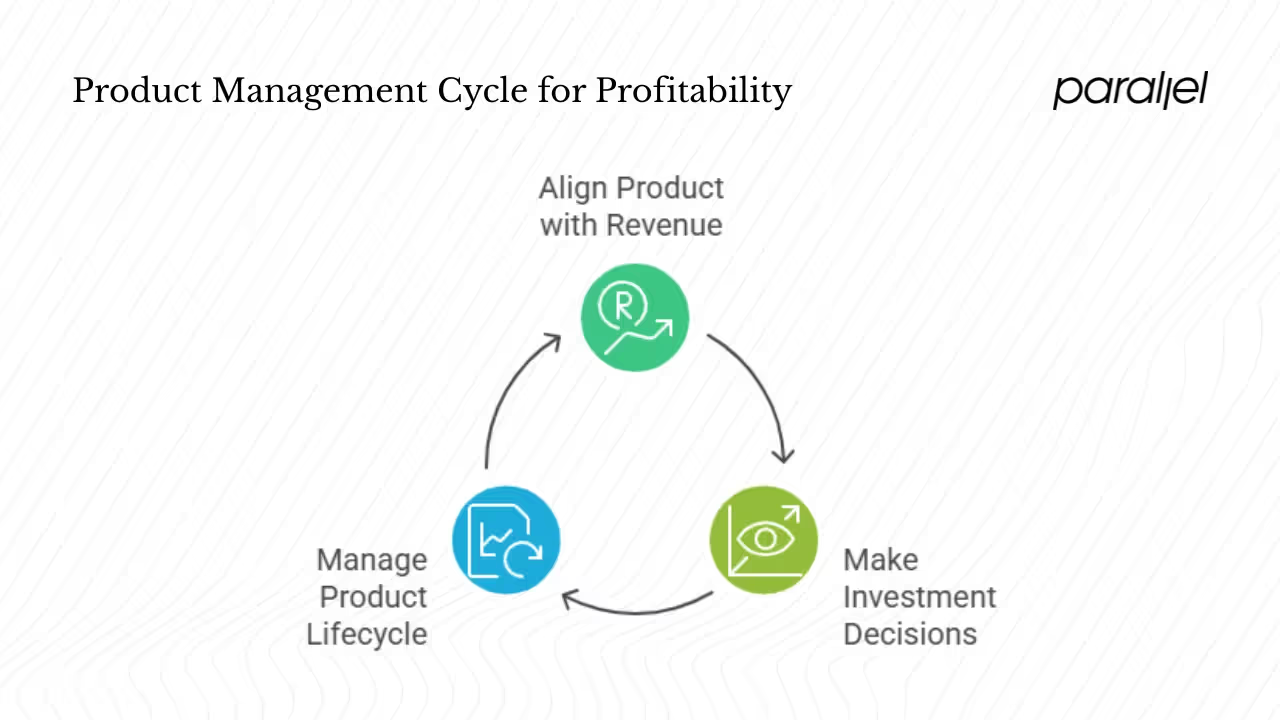
Aligning product with revenue
A product isn’t successful if it doesn’t generate revenue or support the business model. The Kaizen mindset emphasises that continuous improvement should enhance customer satisfaction and business outcomes. The CPO Club argues that product management exists to deliver great products and generate profit. Martyn Bassett Associates note that chief product officers focus on long‑term goals and link product and business strategies. In early‑stage startups, product leaders must think about how features translate into pricing, upsells, retention and cost savings. Decisions about packaging, bundling and monetisation are integral to the product function.
Making investment decisions
Resource allocation is a constant challenge. Product managers decide which features or initiatives merit investment and which should be deferred or cut. This requires understanding cost, potential revenue, user impact and strategic fit. Without this discipline you might waste time on low‑impact work or starve high‑potential initiatives. ProductPlan’s report indicates that nearly 56% of product teams in large organisations are consolidating tools to improve coordination and communication. For startups, adopting lean processes and focusing on the highest‑impact activities can improve ROI and reduce overhead.
Profitability through lifecycle management
Lifecycle decisions affect profitability too. Knowing when to extend, pivot or retire a product prevents wasted resources and opens opportunities for new revenue streams. A product manager monitors metrics like customer acquisition cost, lifetime value, gross margin and payback period. By connecting lifecycle stages with profitability goals, product managers ensure that business growth isn’t at odds with user experience or market fit. This financial stewardship is part of why product management is important.
Risk management and the product lifecycle
Types of risk
Bringing a product to market involves different risks:
- Market risk: building something nobody wants.
- Feature risk: building the wrong features or creating a bloated product.
- Execution risk: failing to deliver on time or to quality due to technical or organisational constraints.
The SEI blog explains that product management helps organisations avoid these traps by maintaining customer empathy and focusing on the right product. When technology, process or product management falters, the product often fails.
Managing risk across stages
Product managers mitigate risk by identifying assumptions early and testing them. During ideation they validate the problem and market size. During development they test prototypes and gather feedback. At launch they monitor adoption and satisfaction. Throughout the lifecycle they balance innovation with stability. If a product reaches maturity, the product manager may decide to sunset it or invest in adjacent opportunities. Timely decisions reduce financial risk and free up resources for new ventures.
Learning from failure
Real stories illustrate these risks. We worked with a SaaS startup that spent a year building a complex dashboard because early adopters requested advanced analytics. When it launched, adoption lagged; most users were still struggling with basic workflows. The product team had skipped discovery and assumed advanced features would drive growth. A strong product management practice would have validated assumptions, rolled out a smaller test and adjusted direction earlier. Failure is inevitable without a process to manage risk—another demonstration of why product management is important.
Putting it all together
When you view product management holistically it becomes clear that it’s the thread connecting strategic planning, customer insight, design, engineering, marketing and operations. Without product management, resources scatter, goals diverge and user experiences suffer. With it, your product has a clear purpose, responds to customer needs, stands out in the market and contributes to the bottom line. This interplay of strategy, customer satisfaction, product development, competitiveness, innovation, profitability, resource allocation, risk management and user experience shows the power of connecting these disciplines through product management. For early‑stage startups, doing product management well early can mean the difference between scaling and stalling.
Visualising the product manager as a hub
Below is a diagram we created to represent the product manager as the central hub connecting the four main disciplines—business strategy, user experience, engineering and market analysis. Each arrow shows the flow of information and influence. This conceptual visual helps teams understand that product management isn’t a silo but a connector.
Practical tips for founders and PMs at early‑stage startups
To translate these insights into action, here’s a set of practical tips and a mini‑checklist. They reflect patterns we’ve seen while working with early‑stage SaaS teams.
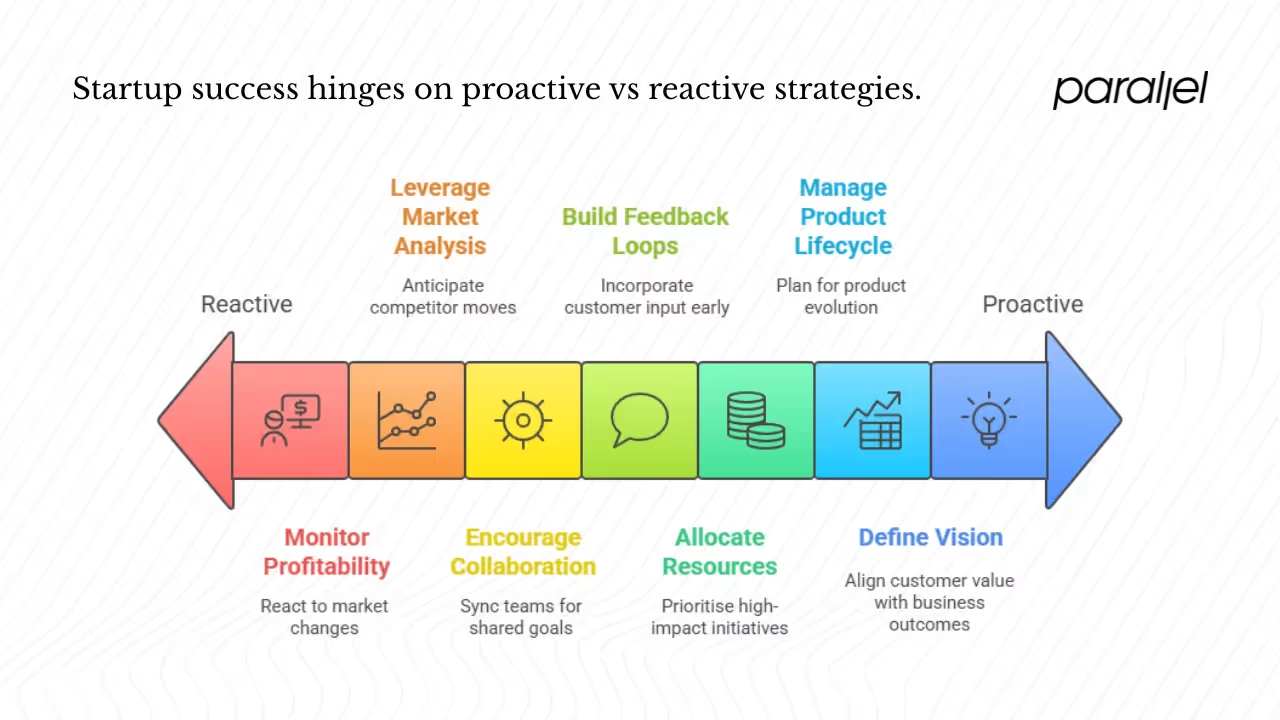
1) Define vision and strategy early
- Write a product vision statement that links customer value to business outcomes.
- Align it with the broader company mission and revisit it regularly.
- Define success metrics from the start; don’t leave them vague.
2) Allocate resources by priority
- Use a prioritisation framework (e.g., RICE, MoSCoW) to rank initiatives.
- Focus on high‑impact features that move important metrics rather than building exhaustive lists.
- Regularly reassess priorities based on new information.
3) Build feedback loops
- Talk to customers early and often. Use interviews, surveys, analytics and user testing.
- Incorporate feedback into the roadmap. When customers see their input reflected in the product, they become advocates.
- Share findings with your team to build empathy and shared understanding.
4) Encourage cross‑functional collaboration
- Schedule short daily or weekly syncs across product, design and engineering to surface blockers and insights.
- Host cross‑team demos to showcase progress and gather feedback.
- Define shared goals and ensure everyone understands how their work contributes to the outcome.
5) Leverage market analysis and competitive intelligence
- Set a cadence for reviewing market trends and competitor moves.
- Document insights and discuss them with the team.
- Encourage experiments based on emerging opportunities.
6) Monitor profitability, risk and time‑to‑market
- Track metrics like customer acquisition cost, lifetime value, payback period and gross margin.
- Set thresholds for releasing features (e.g., time‑to‑market vs. quality trade‑off) and stick to them.
- Identify risks early and plan mitigations.
7) Manage the product lifecycle intentionally
- Recognise when your product is entering growth, maturity or decline.
- Plan for extension, pivot or sunset decisions rather than reacting under pressure.
- Document lessons from each phase to inform future projects.
Mini‑checklist for early‑stage product managers
- Vision: Do we have a clear product vision connected to business goals?
- Problem fit: Have we validated the problem with real users?
- Metrics: What metrics will we track for success and why?
- Prioritisation: Are we focusing on the highest‑impact features?
- Feedback: When is our next customer feedback session?
- Alignment: Do engineering, design and sales understand the roadmap and rationale?
- Market watch: What competitors or trends could disrupt us next?
- Lifecycle: What stage is the product in and what’s our plan for the next stage?
- Risk: Have we identified our biggest assumptions and how to test them?
- Profitability: How will this feature or product drive revenue or reduce cost?
Conclusion
Product management sits at the junction of business, customers, market and execution. It turns vision into a tangible product, ensures user needs are met, guides teams through uncertainty and ties back to profitability. In early‑stage startups where resources are limited and speed matters, why product management is important becomes even clearer: it keeps teams focused on the right problems, helps them learn quickly, encourages collaboration and brings actions in line with strategy. If you’re a founder or product leader, ask yourself today: Do we have a clear vision? Are we listening to users? Do we agree on priorities? Are we measuring success? If the answers are unclear, investing in product management may be your highest‑leverage move.
FAQ
1) Why is product management so important?
Product management ensures a product has purpose, meets user needs, matches business goals and competes in the market. The CPO Club argues that product management is the most important function because without a team delivering a solid product a company’s prospects are poor. A product manager acts as the connective tissue among strategy, customer insight, engineering and operations. They prioritise the right work, facilitate collaboration, interpret data and adapt to change. In a world where 95% of products fail, a disciplined product management practice increases the likelihood of success.
2) What are the 5 C’s of product management?
Various frameworks list different “5 C’s.” One common version considers Company, Customers, Competitors, Collaborators and Context. Product managers must understand their company’s goals, deeply know their customers, monitor competitors, collaborate with partners and consider the broader context (technological, regulatory and economic). Another variant sometimes substitutes Cost or Channel depending on the industry. Regardless of the variant, the point is to take a holistic view across internal and external factors before making decisions.
3) What is the main goal of product management?
The main goal is to deliver value to customers and the business by guiding a product from idea through to success in the market. This involves achieving product‑market fit, driving adoption, generating revenue and continuously improving the product. Product managers synthesise market research, user insights, business strategy and technical constraints to decide what to build and why. Without this guidance a product risks drifting away from both customer needs and business objectives.
4) What are the 5 P’s of product management?
The “5 P’s” originally come from marketing, but they map well to product management:
- Product: The solution you’re offering, including functionality and design. Product managers define the vision, prioritize features and ensure user needs are met.
- Price: How you monetise the product. Product managers influence pricing strategies by understanding value perception, customer segments and revenue goals.
- Place: Where users find and experience the product—whether in an app store, web platform or through enterprise sales. Product managers work with marketing and sales to choose the right channels.
- Promotion: How the product is marketed. Product managers collaborate with marketing to ensure messaging reflects product value and resonates with target users.
- People: The users and the internal team. Product managers represent users internally and build strong relationships across engineering, design, sales and support.
By considering these aspects, product managers ensure the product is not only well built but also well positioned to succeed.

.avif)











